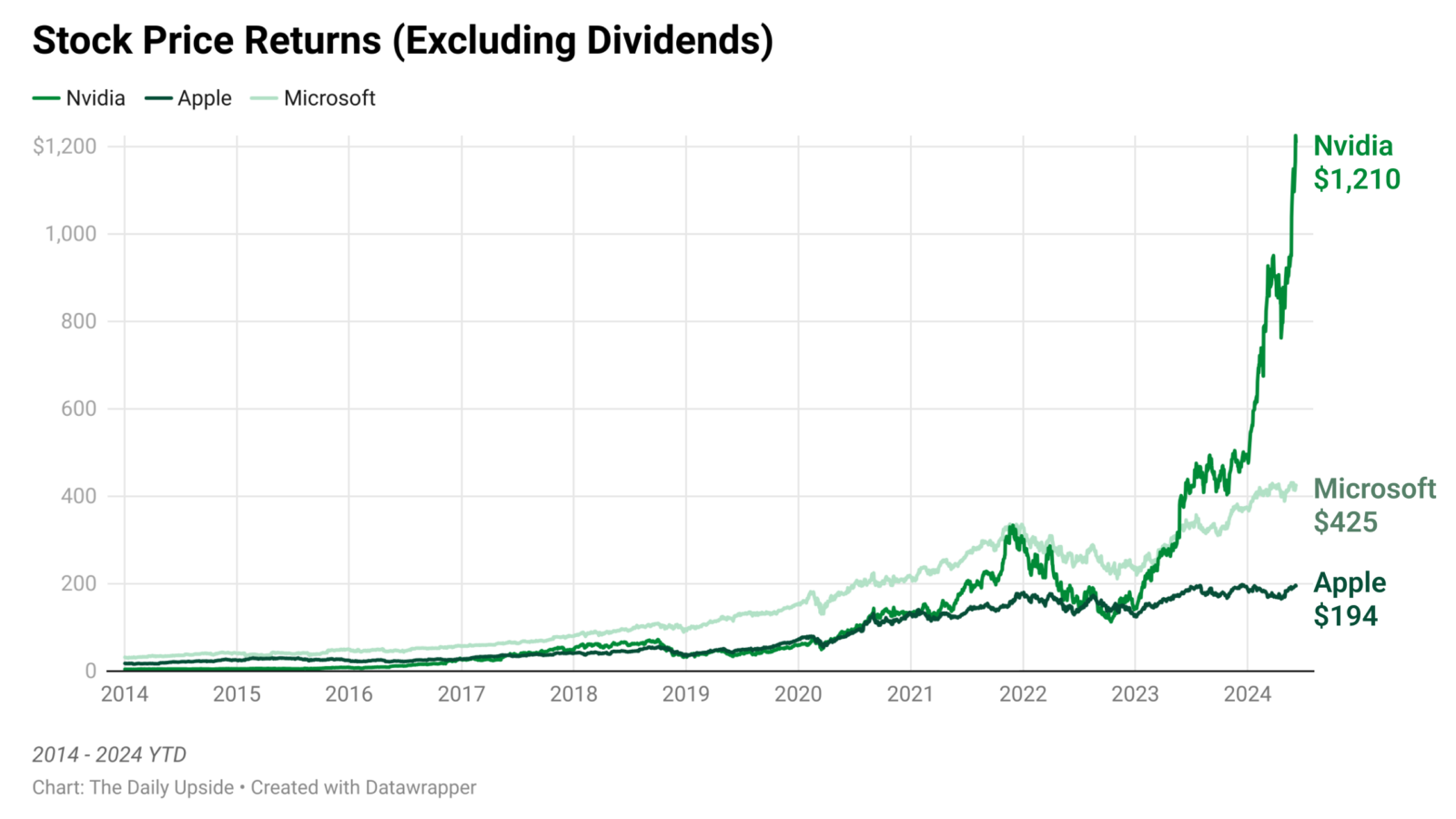Good morning and happy Friday.
Meme-stock investors are purring with pleasure.
Shares of GameStop jumped another 30% on Thursday after ringleader Keith “Roaring Kitty” Gill announced a YouTube livestream for Friday, marking his first such public event since kickstarting the movement nearly four years ago. Since Gill signaled his return last month, GameStop’s share price has surged 80%. Last Sunday, he let the cat out of the bag, posting screenshots of his E-Trade portfolio revealing a GameStop position that would now be worth roughly $200 million. He’s a richer cat now.
AI Enters its Antitrust Era
Trustbusters are coming for AI.
This week, the Federal Trade Commission and Department of Justice have seemingly agreed on a battle formation for probing the rollicking world of generative AI for antitrust issues, according to multiple reports. Both agencies have stuck thorns into Big Tech’s side, and they’re eager to investigate exactly how the companies may be carving up the generative AI pie in anti-competitive ways. The question this time around: Have Big Tech companies become a little too smart?
Acqui-hire Fire Sale
The New York Times reported that the FTC and DOJ have jointly decided which agencies will go after which companies. According to the NYT, the DOJ will take the lead on chipmaker Nvidia, while the FTC will run point on OpenAI. This reportedly marks a detente for the two government agencies, as Politico reported in January that they tussled over who got to investigate OpenAI, the darling of the generative AI hype cycle.
The FTC isn’t limiting itself to OpenAI. The Wall Street Journal reported on Thursday that the FTC also will investigate a deal Microsoft struck with AI startup Inflection AI. What will prove key in this new era of antitrust wrangling isn’t just whether large tech companies are winnowing down the competitive landscape too much, but whether they’ve been too sneaky about it:
- Microsoft didn’t buy Inflection AI outright, but it did hire its cofounder and most of its staff while kicking the company $650 million as a licensing fee. This has the classic hallmarks of an “acqui-hire,” and the FTC is looking into whether the deal was structured specifically to avoid the scrutiny that comes with acquisitions over $119 million, per the WSJ.
- Microsoft has also maneuvered itself into an influential position in the AI landscape through its investment in OpenAI, and other Big Tech companies have followed suit. Amazon invested in AI startup Anthropic.
AI Misgivings: It’s been a slightly zesty week in generative AI. Meta’s head of AI, Yann LeCun, has been publicly squabbling with Elon Musk, and current and former employees at OpenAI, plus a handful from Google’s DeepMind unit, wrote an open letter calling for increased oversight of AI and more robust whistleblower protection. Stick it on the regulator tab.
The Newsletter Company Wall Street Can’t Stop Reading
For nearly two decades, Puck founding partner Bill Cohan has been one of the most plugged-in reporters on Wall Street. His private email newsletter, Dry Powder, is required reading for anybody connected to the capital markets.
Bill writes for Puck, a membership-driven digital media company for the investor class, along with a dozen other name-brand reporters.
To wit: Puck’s Marion Maneker is the most accomplished journalist covering the $65 billion art market. Marion writes a private email offering unparalleled intelligence on the biggest auctions and galleries, private buyers and sellers, and the power players who run this opaque world.
You can start reading Bill, Marion, and everyone else at Puck for free when you sign up for a 14-day trial with Puck.
Don’t miss Bill’s recent piece on the eleventh-hour twists in the Paramount Global deal saga, and Marion’s report on the Gagosian succession sweepstakes.
FDA Reverses its Ban on Juul
What’s that smell? Cool cucumber-flavored nicotine vapor.
On Thursday, the US Food and Drug Administration reversed its ban on Juul e-cigarettes as it plans a review of new company data and case law derived from various recent lawsuits. Of course, the agency’s initial ban in 2022 quickly became a ban in name only.
Run the Juuls
In the years leading up to the FDA’s crackdown, Juul exploded in popularity; In a report last year, the agency found that monthly e-cigarette sales had boomed 50% between January 2020 and December 2022 (Juul held a strong second place in the industry, behind Vuse, a subsidiary of cigarette giant Reynolds American).
In 2020, the FDA ordered Juul and its industry competitors to submit scientific research proving the products were less harmful than regular ol’ smokes, and, by June 2022, the FDA banned Juul from the market due to four unresolved questions related to the toxicology data. Juul quickly appealed the order — and the FDA allowed it to stay on shelves through the process. On Thursday, the FDA officially rescinded the 2022 ban-that-wasn’t, though the product remains under agency review.
That keeps Juul in something of a state of limbo. The status quo has been anything but stable:
- The 2022 ban sent Juul into chaos. Just four years prior, Marlboro-maker Altria had invested $12.8 billion into the company for a 35% stake; less than a year after the ban, Altria effectively closed out its position in a move that valued its stake at just $250 million.
- Following the ban, Juul also narrowly averted filing for bankruptcy, though it was ultimately bailed out by two longtime investors and board members: Hyatt heir Nick Pritzker and venture capitalist Riaz Valani. But now, in an ongoing case, other Juul investors have filed a lawsuit against the company, alleging Pritzker and Valani benefitted themselves at the expense of the company and its investors.
Zynception: What’s worse is that in the time since Juul’s 2022 quasi-ban, smokeless tobacco products, like the Zyn pouches made by Phillip Morris, have essentially disrupted e-cigarettes in a similar way the vapes disrupted regular cigarettes. In fact, smokeless products accounted for nearly 40% of Phillip Morris revenue last year, a roughly 21% surge. Juul’s business, in other words, is going up in smoke.
Nvidia Is On its Way to the Top of the Market-Cap Leaderboard — Then What?

By the time Nvidia went public in 1999, Microsoft and Apple had been going at each other for two decades. But it’s more than made up for lost time.
On Wednesday, Nvidia shares closed higher to push the company’s market cap above $3 trillion for the first time ever, surpassing Apple as the second-most valuable publicly traded company in the US (it fell back below that level on Thursday).

Given how quickly it got there, it seems like only a matter of time before it makes up the $145 billion ground on Microsoft for the No. 1 spot. But should traders be celebrating or bracing for impact?
Can’t Stop, Won’t Stop
Prior to the 2010s, Nvidia’s market-leading graphics processing units built their success on PC gamer nerds trying to get Crysis — a first-person shooter that required top-of-the-line hardware — to run on their homemade rigs. But with the advent of crypto mining, cloud computing, and artificial intelligence, the GPU business has entered a new realm of never-before-seen demand. Now, they’re being used to develop machine learning and train large language models. In English: They make computers faster and more powerful. Nvidia, already a pioneer in the GPU sector, quickly ascended to rock-star status:
- Microsoft’s and Apple’s market caps increased 825% and 440%, respectively, over the past decade. That’s not bad! But it pales next to Nvidia, which has seen its market cap skyrocket by almost 28,000%. Just six years ago, this $1,200 per-share stock was trading at about $50.
- Big Tech companies account for roughly 20% of the entire S&P 500, and all three companies reached the triple-trillionaires market cap club within the last year. However, Nvidia is a younger stock, going public in 1999. Plus, it’s only been about a year since Nvidia hit the $1 trillion milestone.
Faster than a Speeding Bullet: When companies grow that much that quickly, fears of a reversal aren’t far behind. And Nvidia’s run has been so unprecedented that it’s especially nerve-racking. Not to mention that its trailing-twelve-month price-to-earnings ratio sits at about 70, nearly double the 31 or so average of the entire Nasdaq 100. And one can’t ignore CEO Jensen Huang’s disclosure that he plans to sell up to $735 million in stock over the next 10 months (yes, it’s one of those preset trading plans).
But Nvidia’s financials are walking the walk, unlike, say, Pets.com in 1999. In its most recent quarter, the company’s revenue jumped 262% and net income rose 462% to $15.2 billion (those are real numbers!) Last month, CNBC’s Jim Cramer said Nvidia will soon surpass Microsoft at the market cap peak, saying its “chips are the backbone of AI advancements,” and that its products are “increasingly becoming integral to the tech infrastructure, making it a company that could redefine the future of technology.” Just this week, Elon Musk said his companies will spend between $3 billion and $4 billion on Nvidia hardware this year. No company is too big to fail, but Nvidia is getting pretty close.
Extra Upside
- You talkin’ to me? Tribeca Film Festival will screen AI-generated films.
- Going my way: Ride-share service Revel claims its salaried employees would rather be contract workers.
- Discover the Future of Technology with Patent Drop. Our bi-weekly newsletter tracks the latest patents filed by big tech (like Apple, Meta, Tesla). Stay ahead of the curve and subscribe for free today.*
* Partner

